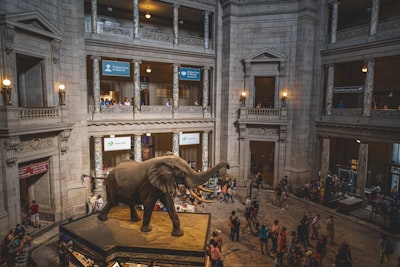by Lauren Harrison, Idaho Capital Sun
May 24, 2022
Visitors to many national parks in the U.S. notice and enjoy the iconic buildings made with local materials. These structures are so unique that the style of architecture has its own nickname — “Parkitecture.” But where did this style come from, and how has it persevered over the last century in Yellowstone National Park?
The park, created in 1872, was such a remote destination that early visitors camped or stayed in hastily-constructed, ramshackle accommodations. As railroads were built to provide access to the area, demand rose for more and better accommodations.
The Old Faithful Inn wasn’t the first hotel built — the Mammoth and Lake hotels are older — but it is arguably the first example of a new style of architecture that would eventually come to be called “National Park Rustic.” This style was born from a movement that strived to connect architecture to the surrounding landscape, incorporating natural materials and the “feel” of outdoor spaces into the design of buildings.
Although it didn’t exist as a category at the time, the architect of the Old Faithful Inn, Robert C. Reamer, summarized the style succinctly in describing his approach to the (at the time) radical design: “I built (the inn) in keeping with the place where it stands. Nobody could improve upon that. To be at discord with the landscape would be almost a crime. To try to improve upon it would be an impertinence.”
Old Faithful Inn was built in 1903–1904 for the bargain price of $140,000, mostly due to the use of local materials. The Department of the Interior granted a special permit for harvesting of trees, resulting in the use of local lodgepole pines for much of the timber constructing the building, including the unique knobby pine brackets of the interior balconies. Rhyolite blocks were cut from a lava flow that formed a cliff at nearby Black Sand Basin to provide the stones for the building’s foundation and the soaring four-sided fireplace that, at over six stories tall, is the focal point of the main lobby.
The building is the largest log structure in the world — the lower story of the inn alone required 10,000 logs!
The inn has survived — not completely unscathed — two large earthquakes that have occurred in or near the park. In 1959, the inn was rocked by a magnitude 7.3 earthquake just east of the Park at Hebgen Lake. In 1975, the area was shaken again by a magnitude 6.1 earthquake centered near Norris Geyser Basin.
The 1959 earthquake caused some of the brick and stone chimneys of the building to buckle or collapse, and the top portion of the main building itself twisted slightly — the fireplace in the main lobby shifted 1.5 inches from plumb from the event. The chimneys were rebuilt and the roof repaired, but the crow’s nest at the top of the lobby where musicians used to play for the enjoyment of visitors in the evenings, along with the soaring widow’s walk, became unsafe for access. These areas are still closed to visitors today but are visible from below.
Reassuringly, in 2004, the entire inn was reinforced with steel supports as part of a seismic safety refit.
In 1988, the inn was again threatened by natural events when the largest fires in the history of the park burned for four months. These fires were actually 51 different fires that cumulated in a total burn area of approximately 800,000 acres.
The North Fork Fire, ignited by a careless cigarette on July 22, came within a few hundred meters (yards) of Old Faithful Inn. Roof sprinklers (fortuitously installed the previous year), the efforts of firefighters to spray the building continuously with water, and the fire break around the building comprised by parking lots and the surrounding geyser basin saved the building from burning during a firestorm on Sept. 7, 1988. On that day, the fires surrounded Old Faithful Inn on all sides, and at one point all the roads out of the area were blocked.
Miraculously, no one was injured in the effort to save the inn.
Recognizing the Old Faithful Inn as one of the “premier rustic structures in the country and one of America’s grand old hotels,” the structure and surrounding historic buildings were designated as a National Historic Place in 1982. Continued efforts to preserve the building cumulated in the inn being designated a National Historic Landmark in 1987. This designation is for buildings deemed to be “nationally significant in American history and culture,” a distinction that the Old Faithful Inn shares with only about 2,600 properties in the United States.
There are many examples of National Park Rustic style buildings in Yellowstone, including four museums built in the 1920s (the Norris Geyser Basin, Madison, Fishing Bridge, and Old Faithful trailside museums), along with the Old Faithful Inn.
The next time you drive through Yellowstone, consider adding a stop at one of the examples of National Park Rustic architectural style. Enjoy the natural materials designed to blend into stunning environs and appreciate the “radical” design choices of these welcoming and comfortable structures. And appreciate that the Old Faithful Inn has survived 118 years of events in Yellowstone, including large earthquakes and wildfires — that’s more than a human lifetime, but barely a blink of an eye in geologic time.
Yellowstone Caldera Chronicles is a weekly column written by scientists and collaborators of the Yellowstone Volcano Observatory. This week’s contribution is from Lauren Harrison, postdoctoral researcher with the U.S. Geological Survey.
Idaho Capital Sun is part of States Newsroom, a network of news bureaus supported by grants and a coalition of donors as a 501c(3) public charity. Idaho Capital Sun maintains editorial independence. Contact Editor Christina Lords for questions: info@idahocapitalsun.com. Follow Idaho Capital Sun on Facebook and Twitter.
RECOMMENDED READING




